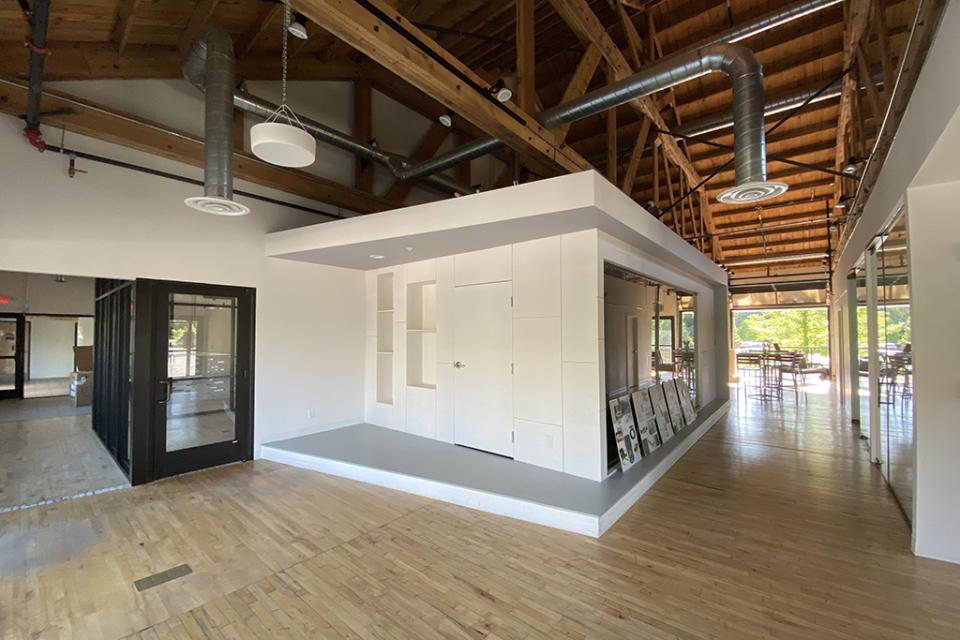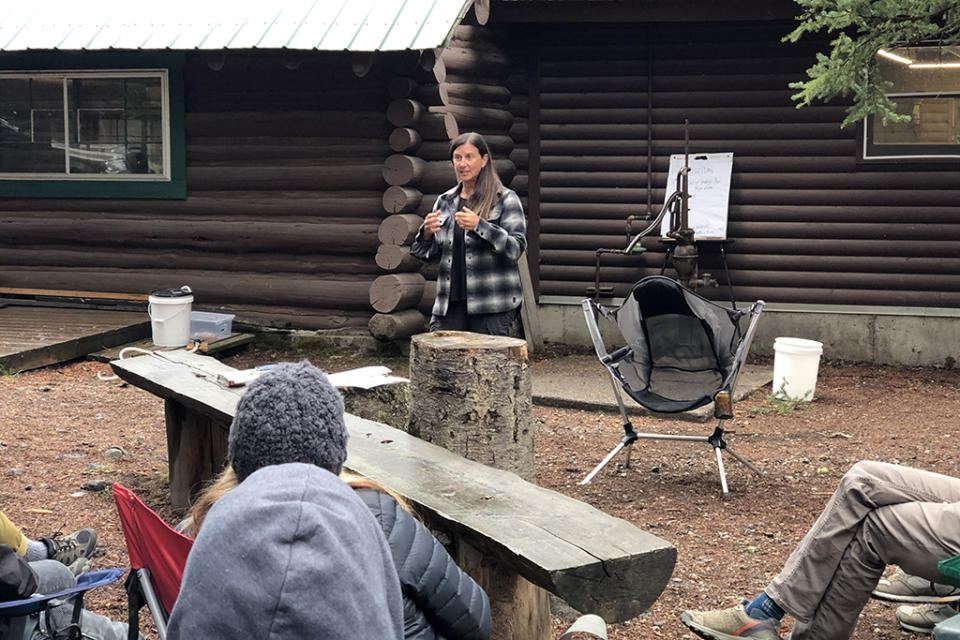Oboz President Amy Beck on Winning With Women, the Supply Chain Backlog and Entering E-Commerce

The hiking boom has been good to Oboz.
Since COVID-19 arrived stateside, the outdoor brand has experienced peaks in its business that could provide momentum for seasons to come. For starters, sales increased 3.8% to $22.1 million for its fiscal first half of 2021 — a company record. FN witnessed evidence of Oboz’s rapid growth last month, after visiting its new, larger headquarters in Bozeman, Mont., across from its former home and within steps of a heavily trafficked trail system. Execs said the move was a necessity as the brand added 15 people in the past year-plus and continues to hire more.
More from Footwear News
Why Oboz Took a Big Risk in Updating Its Beloved Sawtooth Hiking Boot
Oboz Moves Into New Montana Headquarters After Nearly Doubling Its Staff During COVID-19

Peter Verry
Perhaps most importantly, Oboz, a division of Kathmandu Holdings Ltd., continues to win in the critical outdoor specialty retail channel.
Curt Smith, president of Bozeman-based retailer Schnee’s, told FN Oboz was its No. 1 brand in hike, fueled by the best-selling Sawtooth and Bridger boots. “In the hike category, you can demonstrate to the customer that Oboz is the best,” Smith told FN. “If you spend $110 or $130 on a shoe, there’s no reason to buy the other brands because Oboz shoes are way better.”
Although the brand resonates with both genders, Oboz has separated itself from the pack as a go-to for women. According to The NPD Group Inc., for the first half of 2021, the brand’s women’s hiking business was up 144% compared with 2020. “The product is right for her, and they’re certainly not just shrinking and pinking,” said Matt Powell, NPD’s senior sports industry adviser. “There’s a high level of interest on the part of women for hiking and walking, so you’ve got to a customer with an inclination and you’ve got product that resonates with her.”
At Colorado-based Treadz Shoes, owner Jon Zalinski confirmed that his female shoppers are buying Oboz more than any other brand, specifically the Sawtooth and Firebrand looks.
These wins have come under the leadership of industry-veteran Amy Beck, who joined Oboz as president in April 2019 after stints at VF Corp.-backed Smartwool, as well as Lucy Activewear, Cole Haan and others.

Courtesy of Oboz
But the accomplishments haven’t come without challenges. Perhaps the biggest obstacle right now is the global supply chain backlog, which has also affected Oboz. Rather than diminish the impact, though, Beck has opted to be more up-front with retail partners, offering them detailed updates to start an honest dialogue. “We are going to have to make tough decisions,” Beck told FN. “We won’t be able to do everything exactly the way we want to, but if there’s anything we’ve learned, navigating challenges is now the new way we do business.”
Below, the executive shares more insight into the brand’s unique strategy.
What contributed to the strong growth in the first half of fiscal 2021?
AMY BECK: “With COVID, we pulled back on our expectations because we didn’t know what was going to happen. The demand for the brand was high, as well as hiking in general, and it exceeded our expectations. Now we’re trying to capitalize on that for the right reasons: to get more people outside, give them a good experience so they’ll keep coming back to the industry for more. We’re doing a lot on the education front, on access and awareness, working within communities on trail knowledge, partnering with Leave No Trace. We’re not only selling product, we’re also making sure the experience continues to build so we keep those customers.”
How is the back half of the year looking?
AB: “We will have to overcome some challenges. Vietnam is closed, so our factories are closed, which is a bummer — but it’s more of a bummer because we’re in a global health crisis, not because we can’t make more shoes. We will see some residual [impact]. We won’t know how much, but we anticipate it being a blip and then we will continue to recover. Our real focus is on delivering for our new fiscal year 2022 because we have a lot of new products.”
How have you navigated supply chain issues?
AB: “We haven’t been able to meet our full demand, but we’re proud of our ability to deliver through spring — we had a high percentage of delivery of our pre-season order book. I think this is changing behaviors within the industry, which isn’t necessarily bad. It’s getting people to commit up front, getting information to the factories earlier, prioritizing your core business. This is going to have an impact across the market for the next year plus.”
What other trends that emerged in the pandemic do you think will remain — or disappear?
AB: “I hope people who have found respite outdoors around mental and physical health continue to do so. We’re busy, busy, busy — everybody is always moving about, we’re always overbooked, but I’m hoping we can keep more people outdoors. Travel is going to change completely. We never thought twice about getting on a plane to do something, but now we know we can do things without that, so when we do show up, we need to make sure we’re showing up in an intentional way. If we travel in the market, we want to: connect with our consumers, connect with our retail partners and get something personally from it. And then digital. We now know we all can do things digitally. Do we like it? No, but can we be more efficient and show up in more places and build a different type of connection? Yes.”
In April you launched an e-commerce site. Why make the move now?
AB: “We’re much more a brick-and-mortar-focused brand, but during COVID we realized we didn’t have the ability to have a one-on-one connection with our consumer, which we do through our retail partners. We had a plan to launch, and when we started to see our challenges with inventory, we said to Kathmandu, ‘We’re going to launch, but we are not going to have a lot of product because we are not going to prioritize our DTC over our retail partners.’ We made the decision collectively to tell the brand experience and learn about what works and what doesn’t. We only launched with available to sell; it’s product that if you’re a retailer you could call up and get it. We weren’t holding inventory. It is a beautiful site and we have a high level of activity, but it didn’t change much for us; it’s just now you can transact.”
Where will brick-and-mortar versus e-commerce settle out?
AB: “I think there is a push back toward specialty, toward local as people have had to stay within their communities. Specialty is going to continue to thrive because they have the ability to connect in different ways with their consumer. But the digital age, it’s going to continue to grow. I just hope that after COVID, we see both entities grow. A lot of people were predicting the demise of brick-and-mortar, but I think the human connectivity, the expertise and the commitment to communities is going to resonate, especially that outdoor community.”
How will Oboz keep the momentum in 2022?
AB: “Our strategy continues to be to get as many outside and enjoying their journey. That means we have to drive participation, get more people outside, increase the amount of time people go outside and celebrate the rewards of being on trails. You will see us connecting more deeply through partnerships and stories, as well as thoughtful product launches.”
Why does Oboz appeal so well to female outdoor consumers?
AB: “We offer products that accommodate her needs, and I also think that we’re very accessible to a big group of consumers, so our sales are split evenly [between men and women]. We want to lean in even further to her through product, aspiration, color, women’s-specific fit. And we’re spending a lot of time on our marketing efforts, making sure we’re balancing the conversation around how we showcase people out in the outdoors, showcasing her in hiking. Also, women are very social, so we’re playing a little bit on that. We’re not that big, get-to-the-top-of-the-mountain brand, so I think women appreciate that accessibility and approachability.”
Much of the team at Oboz is female. Was that intentional?
AB: “What was intentional was thinking about a more diverse group of people. As we grow, we’re looking for diversity not only in age and gender, but we’re also looking to build on justice, equity, diversity, inclusion. What’s also intentional is looking to build a lot of different skill sets within the team.”
As one of the few female leaders in the outdoor market, do you have a network to lean on?
AB: “I’ve been in the business for a while, so I have my own personal board of directors. I have met a lot through Camber Outdoors, which was originally the Outdoor Industries Women’s Coalition. I was at Smartwool for 11 years, so Jen McLaren and I worked together on the leadership team, and then there’s Nora Stowell from Gore. I sit on the board of the Conservation Alliance, so I have built my network through that organization as well. And Business for Montana Outdoors has been a great way for me to connect within the state of Montana.”
Best of Footwear News
Shop Under Armour Shoes and Apparel Starting at $17 for Amazon Prime Day
Celebrate LGBTQ Pride Month With Gear From Brands That Give Back
Sign up for FN's Newsletter. For the latest news, follow us on Facebook, Twitter, and Instagram.

